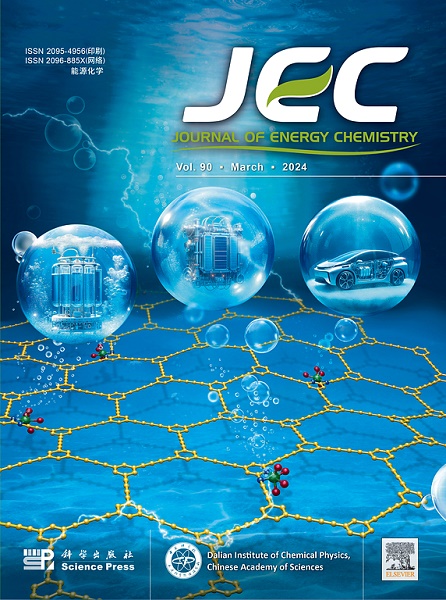通过促进水分子在MgO/CuO催化剂上的活化促进CO2电还原生成C2H4产物
IF 13.1
1区 化学
Q1 Energy
引用次数: 0
摘要
电催化CO2还原反应(CO2RR)制乙烯(C2H4)是一种很有前途的减少CO2排放和生产高价值化学品的方法。乙烯产率一直受到反应动力学缓慢的限制,因此迫切需要高性能的催化剂。为了开发一种催化剂来激活二氧化碳分子,人们做了很多努力。然而,作为另一种反应物,H2O活化并没有得到应有的重视。特别是,缓慢的H2O解离动力学限制了质子供应的速度,严重损害了C2H4的产生。在此,我们设计了一种MgO修饰的CuO催化剂(MgO/CuO),该催化剂可以促进H2O解离,同时增强CO2吸附,从而实现高效乙烯生产。最佳催化剂在h -电池中,C2H4的法拉第效率在−1.4 V vs. RHE下达到54.4%,是纯CuO(37.9%)的1.4倍,在流动电池中进一步提高到56.7%,在−1.0 V vs. RHE下电流密度高达535.9 mA cm - 2。实验和理论计算表明,MgO/CuO在CO2RR中起双功能作用,促进CuO对CO2的吸附和活化,同时加速MgO掺杂对H2O的解离。原位XRD实验表明,MgO的引入保护了CuO活性相,避免了过还原,保留了CO2RR的活性中心。结合原位FTIR和DFT计算,MgO/CuO上增强的水活化和质子偶联促进了*CO到*COH的质子化过程和不对称C-C偶联步骤。这项工作为CO2RR中CO2和H2O的共活化机制提供了新的见解,并为设计乙烯生产电催化剂提供了潜在的通用策略。本文章由计算机程序翻译,如有差异,请以英文原文为准。

Promoting CO2 electroreduction to C2H4 product by promoting water molecules activation on MgO/CuO catalyst
Electrocatalytic CO2 reduction reaction (CO2RR) to ethylene (C2H4) represents a promising approach to reducing CO2 emissions and producing high-value chemicals. The ethylene productivity is always limited by the slow reaction kinetics and the high-performance catalysts are significantly desired. Many efforts have been made to develop a catalyst to activate CO2 molecules. However, as another reactant, H2O activation does not receive the attention it deserves. In particular, slow H2O dissociation kinetics limit the rate of proton supply, severely impairing the production of C2H4. Here, we designed a MgO-modified CuO catalyst (MgO/CuO), which can promote H2O dissociation and enhance CO2 adsorption at the same time to realize the efficient ethylene production. The optimal catalyst exhibits a Faraday efficiency for C2H4 reached 54.4% at −1.4 V vs. RHE in an H-cell, which is 1.4 times that of pure CuO (37.9%), and it was further enhanced to a 56.7% in a flow cell, with a high current density of up to 535.9 mA cm−2 at −1.0 V vs. RHE. Experimental and theoretical calculations show that MgO/CuO plays a bifunctional role in the CO2RR, which facilitates the adsorption and activation of CO2 by CuO and simultaneously accelerates H2O dissociation by MgO doping. The in situ XRD experiments demonstrate that the introduction of MgO protects CuO active phase to avoid overreduction and preserves the active centers for CO2RR. In combination with in situ FTIR and DFT calculations, the protonation process from *CO to *COH and asymmetric C–C coupling step are promoted by the enhanced water activation and proton coupling on MgO/CuO. This work provides new insights into the CO2 and H2O coactivation mechanism in CO2RR and a potential universal strategy to design ethylene production electrocatalysts.
求助全文
通过发布文献求助,成功后即可免费获取论文全文。
去求助
来源期刊

Journal of Energy Chemistry
CHEMISTRY, APPLIED-CHEMISTRY, PHYSICAL
CiteScore
19.10
自引率
8.40%
发文量
3631
审稿时长
15 days
期刊介绍:
The Journal of Energy Chemistry, the official publication of Science Press and the Dalian Institute of Chemical Physics, Chinese Academy of Sciences, serves as a platform for reporting creative research and innovative applications in energy chemistry. It mainly reports on creative researches and innovative applications of chemical conversions of fossil energy, carbon dioxide, electrochemical energy and hydrogen energy, as well as the conversions of biomass and solar energy related with chemical issues to promote academic exchanges in the field of energy chemistry and to accelerate the exploration, research and development of energy science and technologies.
This journal focuses on original research papers covering various topics within energy chemistry worldwide, including:
Optimized utilization of fossil energy
Hydrogen energy
Conversion and storage of electrochemical energy
Capture, storage, and chemical conversion of carbon dioxide
Materials and nanotechnologies for energy conversion and storage
Chemistry in biomass conversion
Chemistry in the utilization of solar energy
 求助内容:
求助内容: 应助结果提醒方式:
应助结果提醒方式:


